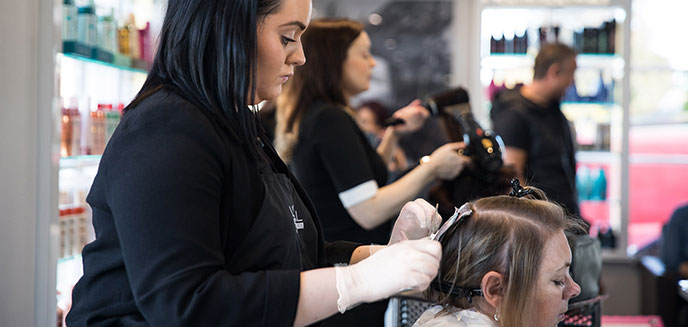Qualifications and training
The NHBF code of conduct states, 'All members of your team [should] have industry-recognised training, experience and qualifications for the services or treatments they provide and the equipment and tools they use’.
In this latest edition of Spotlight, Caroline Larissey, NHBF director of standards and quality, gives a detailed analysis of qualification and training requirements in the hair and beauty sector and the obligations and best practices for NHBF Members to their employees.
Duty of care
To protect the health and safety of clients and to ensure credibility in the hair and beauty sector, employers must ensure that the hair and beauty professionals employed in their salon or barbershop hold the right qualifications for the treatment or services, hairdressing and barbering they will be providing for clients.
The salon or barbershop owner also has a duty of care as the business owner to ensure all chair/space/room renters meet the requirements. However, it is ultimately the chair/space/room renter's responsibility as an independent business to ensure they hold the right qualifications. Otherwise, their insurance will not cover them.
Regulated qualifications
The completion of a regulated qualification is the benchmark required by the sector and insurance providers to demonstrate professional competence to work "on the shop floor" within the sector. This can only be gained by accreditation a qualification from a regulated awarding organisation as detailed in the NHBF qualifications and age restrictions fact sheet.
There is a lot of misinformation regarding the types of qualifications required in our sector. Sadly, there is also a black market in non-accredited education and training. This can be very expensive, misleading, provide little underpinning knowledge or skill and may not meet insurance requirements. These courses and their providers’ lack of accountability when anything goes wrong continue to cause significant damage to the reputation of the sector.

Progression
Progression within the hair and beauty sector can follow different pathways through gaining qualifications available from the various industries within the sector. Academic progression can only be achieved by completing a qualification from a regulated awarding organisation, again as detailed on our qualifications and age restrictions fact sheet.
The only way an employer can genuinely test if a prospective employee has the level of competency that proves they have the ability to "work on the job floor" is by completing a skills test as part of the interview process.
When qualification is accredited for use by a regulated awarding organisation, it has been evaluated by a regulatory organisation as being set at the correct academic level and fit for its intended purpose. The regulatory organisation will also be satisfied that it complies with their published regulatory requirements and the requirements of equality law.
Details of awarding organisations that offer qualifications within the sector can be found in the NHBF Trade Directory. If you are unsure if a regulated certificate is genuine, check out the FISSS apprenticeship framework website. Although not initially intended for this purpose, it has examples of certifications from all Awarding Organisations.
In the hair and beauty sector, regulated qualifications can be classified as a “job ready” or preparation for work qualification.
“Job ready" qualifications are typically delivered "on the job" or in a realistic work environment. Once complete, a hair and beauty professional can demonstrate full job competence and work to commercial timings. Job ready qualifications include apprenticeship standards, apprenticeship frameworks, NVQs and SVQs. Find out more on our apprenticeship page.
Preparation for work qualifications such as vocational, technical, and other general qualifications (VTQs), including traineeships and T-Levels, are practical courses, which have been recognised on par with GCSEs and A-Levels and can carry UCAS points at Level 3. These qualifications prepare a learner to work in the sector, but further skill building (continuous practice) will be required to develop “job ready” competence and commercial timings. This depends on the level, breadth and depth of learning undertaken as part of the qualification and may be called “threshold competence”. With these qualifications, a learner can progress to a higher apprenticeship, university or go straight into a job.
Continued Personal Development
Once a hair and beauty professional has completed a regulated qualification at the correct level for their job role, they will continue to develop their skills, knowledge and competency levels as they work on the shop floor. As skills, services, techniques, and client requirements change, the hair and beauty sector professional will train, adapt and learn whilst working to ensure they are up to date, and can match other businesses in meeting the needs of their clients. It is vital to complete a minimum level of "on the shop floor" experience per year to maintain the skills and standards expected for “job-ready" competence. . Read our blog on the importance of training in your salon.
It is highly recommended that Continued Personal Development (CPD) course or programme should not be levelled. It should detail the job role, skills, knowledge and learning that can be achieved. CPD may enable a practitioner to study further or provide additional breadth and depth of learning.
A training provider should ensure that any course/ training/ programme delivered has clear prerequisites detailing the level and qualifications that need to be achieved before starting the CPD programme.
- It must be clear that the CPD course/ training/ programme is not a qualification.
- Research and word of mouth are always recommended when choosing a CPD course or programme, some may be endorsed or externally quality assured.
- It is highly recommended to always check with your insurance provider that you will be covered.
Always check with your insurance provider that you will be covered for any course you undertake.
For regulated qualifications, an awarding organisation ensures:
- That the training provider meets the regulator's requirements via a robust quality assurance process.
- As part of a training provider’s centre approval, an Awarding Organisations will complete a site approval and ongoing monitoring via an external verification process.
- Prerequisite levels and qualifications, where applicable, are required for all regulated qualifications and are detailed within individual qualification specifications.
Resources
The NHBF training provider guide is FREE to NHBF Members and provides the key steps you need to take to become a professional training provider.
In England, the standards for the sector can be found on the Institute for Apprenticeship and Technical Education Website. Here you will find occupational maps for the hair, beauty and aesthetics sector and apprenticeship standards.
In the devolved nations (Scotland, Northern Ireland, Wales), National Occupational Standards (NOS) are available. They are overseen by the NOS Governance Group and the Standards & Frameworks Panel. The NOS can be accessed via a collectively funded database governed by the devolved administrations and managed on their behalf by Skills Development Scotland. The NOS can be used directly in Scotland to develop the SVQ.

